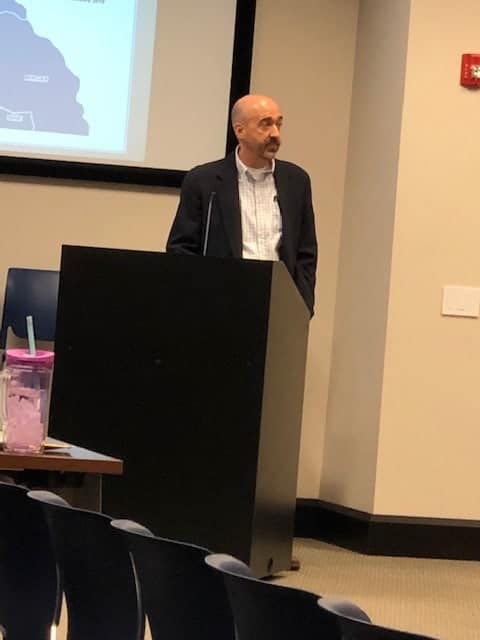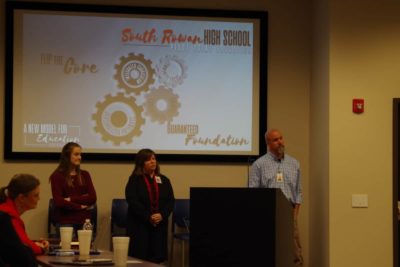
The Rowan-Salisbury School Board met last week to continue deliberations on school consolidation. The system currently has 35 schools, with most far below capacity. The majority of the schools were built in the early to mid part of the 20th century and have significant capital needs. The school system’s Chief Financial Officer Carol Herndon has said that the system cannot continue to financially support them all. The system revealed plans to the public in December to close some small schools and build regional schools to accommodate students.
To help the board identify what schools to retain, Rowan County Planning Director Ed Muire presented data showing areas of greatest growth based on building permits. Once he aligned growth areas with public school enrollment, however, the data showed no relationship.
“It’s difficult to determine a direct correlation between residential growth and public school participation,” Muire said.
He did note that future residential growth seems pointed to the N.C. Hwy 152 corridor, with commercial and industrial growth growing in the Interstate 85 corridor.
Mike Miller, a consultant from Numerix, LLC, presented redistricting options for elementary, middle, and high schools. Each option detailed where students would be moved in the potential closure of their original schools. Some scenarios moved as many as one in three students in the system; others moved only one in seven. Miller presented his original options at an earlier meeting in January and came back to this meeting at the invitation of the board to show additional views.
Board members made no decisions on the matter, but asked for additional options in two weeks for their work session meeting on March 11.
One school being considered for closure is Koontz Elementary, one of the few schools the system built in this century. Because of its proximity to Rowan Cabarrus Community College — it’s only two miles away — the board is considering repurposing the building for a CTE, or career and technical education facility. The school is centrally located in the county, a plus for transportation costs.
Mandy Mills, director of Career & Technical Education for the school system, presented initial suggestions for courses to offer and the associated costs. Mills used data from employer and student surveys to identify those courses with highest interest. She also used a regional jobs report to identify promising jobs in the area.
Using this data, Mills identified seven potential sectors for training at the CTE facility:
- IT
- Advanced manufacturing
- Health care
- Transportation and logistics
- Teacher education
- Hospitality and tourism
- Construction
The system also plans to move the Early College program from Rowan Cabarrus Community College to the CTE facility.
If these seven sectors were developed at the CTE facility, Mills projects a total cost of $201,900 — if the system were to utilize existing district teachers as well as teachers from the community college.
Transportation is another factor, Mills said, as students will attend their traditional high schools for half a day and ride to the CTE facility for the other half. She anticipates a total cost for buses to bring students from their respective high schools and return them to be just under $100,000 a year. Mills confirmed that the CTE facility would be busy all day, with some students attending in the morning and others in the afternoon.
School board members asked if that figure included bus maintenance and upkeep. District transportation director Tim Beck replied that yes, the figure includes driver costs, equipment, fuel, and maintenance.
Architect Paul D. Boney, from the firm LS3P, presented very preliminary plans for repurposing the school. Several of the tracks can be accommodated in the classroom setting. Some of the sectors, however, require larger spaces. The sectors requiring a lab include automotive, logistics, welding, MEP (mechanical, electrical and plumbing), and masonry.
The total cost of repurposing the building, he said, would come in at about $9 million. Furniture, fixtures, and equipment elevate the total to $13 to $14 million. Figures are current, he cautioned, and the inflationary rate for any delays is calculated at 6 percent per year.
The presentation was well received. The board asked several questions and seemed to come to a consensus, though no vote was taken. The board indicated a desire to open the school for the 2020-21 school year. Because Boney says construction will take 10 months, he advised board members to make a decision soon in order to follow the state bid process and start construction in a timely manner. Mills says this plan will allow schools a full year to recruit students to attend the school.
In other business, Boney presented conceptual drawings for a new Knox Middle School. Knox was built in 1958, a time when broad, open campuses were a trend. As a result it’s comprised of six buildings having a total of 43 exterior doors.
“It’s a very porous campus,” Boney said.
Today Knox sits next to Overton Elementary School, separated only by the Knox football field. Boney presented a concept to build a new Knox on the existing football field, keeping both schools open to students throughout construction.
He presented a second option of building a K-8 school on the football field, again, keeping both older schools open through construction.
The middle school option came in at about 135,000 square feet and totaled about $40 million. The K-8 option had about 180,000 square feet and totaled about $52 million. In the K-8 school, administrative services would be central in the building, providing a distinct separation between elementary and middle school students.
Boney said the K-8 option provides a second school in the building for only 12 million additional dollars.
“Because there are economies of scale,” he said.
Board members questioned the student capacities in the options. Because assumed capacities were much higher than enrollment in the current schools, the board asked Boney to return in two weeks with smaller plans and costs.
One final concern for board members was the impact construction might have on traffic. The schools sit on residential-scale roads and construction could snarl morning and afternoon traffic. Boney assured board members they’ve dealt with this issue before, and would work with the North Carolina Department of Transportation to plan ahead.


